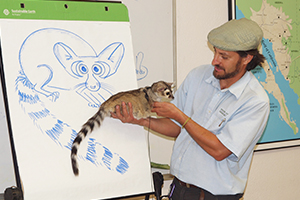When Light Needs a Brake Adjustment
Why does light bend when it meets a hot ground-level layer of air, as in the puddle mirage?
The well-known "speed of light," about 186,000 miles per second (300,000 kilometers per second), is actually light's speed limit. Light zips along that fast only in an absolute vacuum. When light travels under less ideal conditions, such as through ordinary air, it's slower. In effect air puts on the brakes, and the denser the air is, the more forcefully the brakes are applied.
Imagine our Volkswagen bus is a light wave. It's been shrunk to matchbox size and turned on its right side, and it's hurtling obliquely downward toward the ground. Because we're driving through air the brakes are dragging, and the speedometer reads just under light's speed limit-a white-knuckle situation if there ever was one!
At the last instant before impact our right (lower) wheels enter the superheated layer of air just above the pavement. The hot air has expanded, so it's less dense than the cooler air above it. Suddenly the brakes on the right wheels aren't dragging as strongly as those on the left. The right side of the bus starts to move faster and the vehicle pulls to the left, away from the ground. Saved by refraction!
 |
| The part of the light wave in the superheated air near the ground travels faster than the part in the cooler, denser air above it. As a result the wave veers upward, the way a bus with bad brakes pulls to one side. |
Refraction is simply the changing of a wave's direction when different
parts of it move at different speeds. Any kind of wave. Sound waves in
the atmosphere travel faster in the warmer air at lower altitudes than
in the cooler air higher up, so they tend to bend upward, like light in
the puddle mirage. That's why sometimes you can't hear the thunder from
a distant monsoon storm, even though you can see the lightning: the sound
passes above your head! ![]()











